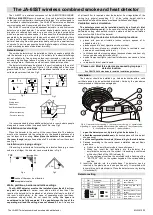
IEQ Chek
Operation Manual
24
1509-9001 Rev 1
Step Procedure to Add/Change a Sensor
4.
If another sensor is to be installed in its place, ensure it is of the same type
(electrochemical, infrared, PID/Catalytic), to be accommodated by the
sensor location recently vacated. Carefully grasp the new sensor by the
sides and line up all of the pins on the smart sensor board attached to the
bottom of the sensor with the sockets on the transmitter board. Once the
pins are all aligned, gently push the sensor down into the sockets in the
transmitter circuit board. If it does not seem to be easy to insert the new
sensor,
DO NOT FORCE IT
. Double check the pin to socket alignment and
try again.
NOTE:
If no sensor is to be utilized in a specific sensor location, the
opening must be filled with a sensor blanking plug to allow sampled air to
reach all sensor locations.
5.
Reattach the sensor cover and tighten the securing screw.
DO NOT
OVER TIGHTEN
.
6.
Switch on the instrument and allow at least 20 to 30 minutes of warm-up
time before using.
7.
Once the sensor has been warmed up and stabilized, perform a zero
function as outlined on page 20. Depending on the sensor, this can be
performed in room air if you know the air in the environment is clean. If the
sensor is CO
2
or O
2
, 100% nitrogen (N
2
) must be flowed over the sensor
as part of the zero function.
Figure 7-2. Transmitter Circuit Board (Top View, Sensor Cap Removed)
SLOT 1
SLOT 2
SLOT 3
SLOT 5
SLOT 4
2
1
3
FRO
NT
O
F I
N
ST
RUM
ENT
FRO
NT
O
F I
N
ST
RUM
ENT
PIN HEADER FOR TOP
MOUNT TEMP AND RH
SENSORS









































